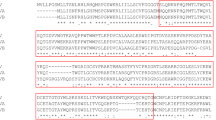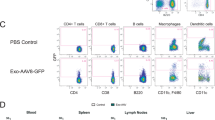Abstract
Gene delivery to dendritic cells (DCs) could represent a powerful method of inducing potent, long-lasting immunity. Although recent studies underline the intense interest in lentiviral vector–mediated monocyte-derived DC transduction, efficient gene transfer methods currently require high multiplicities of infection and are not compatible with clinical constraints. We have designed a strategy to optimize the efficiency and clinical relevance of this approach. Initially, using a third generation lentiviral vector expressing green fluorescent protein, we found that modifying the vector design, the DC precursor cell type, and the DC differentiation stage for transduction results in sustained transgene expression in 75–85% of immature DCs (transduction at a multiplicity of infection of 8). This high efficiency was reproducible among different donors irrespective of whether DCs were expanded from fresh or cryopreserved CD14+ precursors. We then developed procedures that bypass the need for highly concentrated lentiviral preparations and the addition of polybrene to achieve efficient transduction. DCs transduced under these conditions retain their immature phenotype and immunostimulatory potential in both autologous and allogeneic settings. Furthermore, genetically modified DCs maintain their ability to respond to maturation signals and secrete bioactive IL-12, indicating that they are fully functional. Finally, the level of transgene expression is preserved in the therapeutically relevant mature DCs, demonstrating that there is neither promoter-silencing nor loss of transduced cells during maturation. The novel approach described should advance lentiviral-mediated monocyte-derived DC transduction towards a clinical reality.
This is a preview of subscription content, access via your institution
Access options
Subscribe to this journal
Receive 12 print issues and online access
$259.00 per year
only $21.58 per issue
Buy this article
- Purchase on Springer Link
- Instant access to full article PDF
Prices may be subject to local taxes which are calculated during checkout







Similar content being viewed by others
References
Steinman RM . The dendritic cell system and its role in immunogenicity Annu Rev Immunol 1991 9: 271–296
Banchereau J, Steinman RM . Dendritic cells and the control of immunity Nature 1998 392: 245–252
Banchereau J, Schuler-Thurner B, Palucka AK et al. Dendritic cells as vectors for therapy Cell 2001 106: 271–274
Foley R, Tozer R, Wan Y . Genetically modified dendritic cells in cancer therapy: implications for transfusion medicine Transfus Med Rev 2001 15: 292–304
Banchereau J, Briere F, Caux C et al. Immunobiology of dendritic cells Annu Rev Immunol 2000 18: 767–811
Sallusto F, Lanzavecchia A . Efficient presentation of soluble antigen by cultured human dendritic cells is maintained by granulocyte/macrophage colony-stimulating factor plus interleukin 4 and downregulated by tumor necrosis factor alpha J Exp Med 1994 179: 1109–1118
Gilboa E . The makings of a tumor rejection antigen Immunity 1999 11: 263–270
Timmerman JM, Levy R . Dendritic cell vaccines for cancer immunotherapy Annu Rev Med 1999 50: 507–529
Sallusto F, Lanzavecchia A . Mobilizing dendritic cells for tolerance, priming, and chronic inflammation J Exp Med 1999 189: 611–614
Fong L, Engleman EG . Dendritic cells in cancer immunotherapy Annu Rev Immunol 2000 18: 245–273
Kirk CJ, Mule JJ . Gene-modified dendritic cells for use in tumor vaccines Hum Gene Ther 2000 11: 797–806
Reeves ME, Royal RE, Lam JS et al. Retroviral transduction of human dendritic cells with a tumor-associated antigen gene Cancer Res 1996 56: 5672–5677
Szabolcs P, Gallardo HF, Ciocon DH et al. Retrovirally transduced human dendritic cells express a normal phenotype and potent T-cell stimulatory capacity Blood 1997 90: 2160–2167
Chischportich C, Bagnis C, Galindo R et al. Expression of the nlsLacz gene in dendritic cells derived from retrovirally transduced peripheral blood CD34+ cells Haematologica 1999 84: 195–203
Miller DG, Adam MA, Miller AD . Gene transfer by retrovirus vectors occurs only in cells that are actively replicating at the time of infection Mol Cell Biol 1990 10: 4239–4242
Banchereau J, Palucka AK, Dhodapkar M et al. Immune and clinical responses in patients with metastatic melanoma to CD34(+) progenitor-derived dendritic cell vaccine Cancer Res 2001 61: 6451–6458
Arthur JF, Butterfield LH, Roth MD et al. A comparison of gene transfer methods in human dendritic cells Cancer Gene Ther 1997 4: 17–25
Zhong L, Granelli-Piperno A, Choi Y et al. Recombinant adenovirus is an efficient and non-perturbing genetic vector for human dendritic cells Eur J Immunol 1999 29: 964–972
Young LS, Mautner V . The promise and potential hazards of adenovirus gene therapy Gut 2001 48: 733–736
Lewis PF, Emerman M . Passage through mitosis is required for oncoretroviruses but not for the human immunodeficiency virus J Virol 1994 68: 510–516
Naldini L, Blomer U, Gallay P et al. In vivo gene delivery and stable transduction of nondividing cells by a lentiviral vector Science 1996 272: 263–267
Chinnasamy N, Chinnasamy D, Toso JF et al. Efficient gene transfer to human peripheral blood monocyte–derived dendritic cells using human immunodeficiency virus type 1–based lentiviral vectors Hum Gene Ther 2000 11: 1901–1909
Gruber A, Kan-Mitchell J, Kuhen KL et al. Dendritic cells transduced by multiply deleted HIV-1 vectors exhibit normal phenotypes and functions and elicit an HIV-specific cytotoxic T-lymphocyte response in vitro Blood 2000 96: 1327–1333
Schroers R, Sinha I, Segall H et al. Transduction of human PBMC-derived dendritic cells and macrophages by an HIV-1–based lentiviral vector system Mol Ther 2000 1: 171–179
Granelli-Piperno A, Zhong L, Haslett P et al. Dendritic cells, infected with vesicular stomatitis virus-pseudotyped HIV-1, present viral antigens to CD4+ and CD8+ T cells from HIV-1–infected individuals J Immunol 2000 165: 6620–6626
Dyall J, Latouche JB, Schnell S et al. Lentivirus-transduced human monocyte-derived dendritic cells efficiently stimulate antigen-specific cytotoxic T lymphocytes Blood 2001 97: 114–121
Zennou V, Petit C, Guetard D et al. HIV-1 genome nuclear import is mediated by a central DNA flap Cell 2000 101: 173–185
Sirven A, Pflumio F, Zennou V et al. The human immunodeficiency virus type-1 central DNA flap is a crucial determinant for lentiviral vector nuclear import and gene transduction of human hematopoietic stem cells Blood 2000 96: 4103–4110
Zufferey R, Dull T, Mandel RJ et al. Self-inactivating lentivirus vector for safe and efficient in vivo gene delivery J Virol 1998 72: 9873–9880
Zufferey R, Nagy D, Mandel RJ et al. Multiply attenuated lentiviral vector achieves efficient gene delivery in vivo Nat Biotechnol 1997 15: 871–875
Johnston JC, Gasmi M, Lim LE et al. Minimum requirements for efficient transduction of dividing and nondividing cells by feline immunodeficiency virus vectors J Virol 1999 73: 4991–5000
Neil S, Martin F, Ikeda Y et al. Postentry restriction to human immunodeficiency virus–based vector transduction in human monocytes J Virol 2001 75: 5448–5456
Follenzi A, Ailles LE, Bakovic S et al. Gene transfer by lentiviral vectors is limited by nuclear translocation and rescued by HIV-1 pol sequences Nat Genet 2000 25: 217–222
Dardalhon V, Herpers B, Noraz N et al. Lentivirus-mediated gene transfer in primary T cells is enhanced by a central DNA flap Gene Ther 2001 8: 190–198
Zennou V, Serguera C, Sarkis C et al. The HIV-1 DNA flap stimulates HIV vector-mediated cell transduction in the brain Nat Biotechnol 2001 19: 446–450
Morgan JR, LeDoux JM, Snow RG et al. Retrovirus infection: effect of time and target cell number J Virol 1995 69: 6994–7000
Zhou LJ, Tedder TF . Human blood dendritic cells selectively express CD83, a member of the immunoglobulin superfamily J Immunol 1995 154: 3821–3835
Cella M, Salio M, Sakakibara Y et al. Maturation, activation, and protection of dendritic cells induced by double-stranded RNA J Exp Med 1999 189: 821–829
Verdijk RM, Mutis T, Esendam B et al. Polyriboinosinic polyribocytidylic acid (poly(I:C)) induces stable maturation of functionally active human dendritic cells J Immunol 1999 163: 57–61
Gately MK, Wolitzky AG, Quinn PM et al. Regulation of human cytolytic lymphocyte responses by interleukin-12 Cell Immunol 1992 143: 127–142
Manetti R, Annunziato F, Tomasevic L et al. Polyinosinic acid: polycytidylic acid promotes T helper type 1–specific immune responses by stimulating macrophage production of interferon-alpha and interleukin-12 Eur J Immunol 1995 25: 2656–2660
Trono D, Baltimore D . A human cell factor is essential for HIV-1 Rev action EMBO J 1990 9: 4155–4160
Stripecke R, Carmen VM, Skelton D et al. Immune response to green fluorescent protein: implications for gene therapy Gene Ther 1999 6: 1305–1312
Rouard H, Leon A, Klonjkowski B et al. Adenoviral transduction of human “clinical grade” immature dendritic cells enhances costimulatory molecule expression and T-cell stimulatory capacity J Immunol Methods 2000 241: 69–81
Bakri Y, Schiffer C, Zennou V et al. The maturation of dendritic cells results in postintegration inhibition of HIV-1 replication J Immunol 2001 166: 3737–3780
Firat H, Zennou V, Garcia-Pons F et al. Use of a lentiviral flap vector for induction of CTL immunity against melanoma. Perspectives for immunotherapy J Gene Med 2002 4: 38–45
Acknowledgements
This work was supported by the Fonds National de la Recherche Scientifique, Belgium; the Fonds Medic; the Fondation Bekales; the Gene Vector Production Network, Institut Paoli-Calmettes, France; and the Association Française Contre les Myopathies (AFM).
Author information
Authors and Affiliations
Corresponding author
Rights and permissions
About this article
Cite this article
Rouas, R., Uch, R., Cleuter, Y. et al. Lentiviral-mediated gene delivery in human monocyte-derived dendritic cells: Optimized design and procedures for highly efficient transduction compatible with clinical constraints. Cancer Gene Ther 9, 715–724 (2002). https://doi.org/10.1038/sj.cgt.7700500
Received:
Published:
Issue Date:
DOI: https://doi.org/10.1038/sj.cgt.7700500
Keywords
This article is cited by
-
Highly efficient transduction of human plasmacytoid dendritic cells without phenotypic and functional maturation
Journal of Translational Medicine (2009)
-
Enhancement of Myogenic and Muscle Repair Capacities of Human Adipose–derived Stem Cells With Forced Expression of MyoD
Molecular Therapy (2009)
-
Gene Delivery Efficiency in Bone Marrow-derived Dendritic Cells: Comparison of Four Methods and Optimization for Lentivirus Transduction
Molecular Biotechnology (2009)
-
Toll-like receptor 7 and MyD88 knockdown by lentivirus-mediated RNA interference to porcine dendritic cell subsets
Gene Therapy (2007)
-
Use of the PSA enhancer core element to modulate the expression of prostate- and non-prostate-specific basal promoters in a lentiviral vector context
Cancer Gene Therapy (2006)



